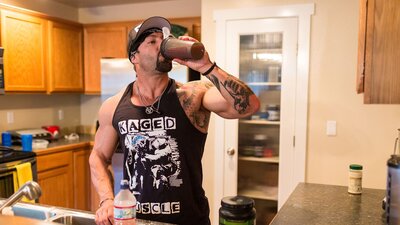The Starting Line | Main | Week 1
Kris Gethin doesn't leave anything in his diet up to chance. Whether he's undergoing a dramatic transformation, building muscle, getting shredded, or throwing himself into entirely new athletic undertakings such as the Man of Iron triathlon prep, he makes sure his nutrition is dialed in from day one.
Swimming, biking, and running multiple times a week—on top of weight training—burns an incredible number of calories, so adding muscle is a challenge. But remember, Kris isn't looking to reinvent his hard-earned physique. As he says a number of times throughout the program, "I want to look like a bodybuilder and function like a triathlete." So it should be no surprise that he eats like he's looking to add muscle.
If you're an ambitious hybrid athlete looking to follow Kris's approach and aim for success in both bodybuilding and endurance sports, you need an approach that takes both goals into consideration. Here's everything you need to know.
Monday-Friday: Muscle Building
For most of the week, Kris follows the basic nutrition approach and calculations laid out in his Muscle-Building Trainer. If you've followed that approach, you know it allows a little more variety than, say, the 8-Week Hardcore Trainer or the original 12-Week Hardcore. Along with protein and carbs, there's room in the food list to add healthy fats, fruit, and even some dairy. This variety is included to fuel your muscle growth, power your diverse workouts, and help you recover from the two-headed assault of the weight room and sport-specific training.
Use the this calculator (the same one used in Kris's Muscle-Building Trainer) to establish your calorie and macronutrient intake during Man of Iron. Enter "Moderate Activity" if this training program is your primary source of physical activity and you don't, for example, work a strenuous physical job as well. But if you start the program and find a week or two in that you're dropping weight or not recovering adequately, recalculate under "Very Active."
This calculator provides the numbers you need for both training and rest days. The food list you follow on Man of Iron will also be the same as in the Muscle-Building Trainer. Be warned: your body will be screaming for calories both good and bad, and you'll need to keep stuffing only good ones into it until it finally shuts up. There are no cheat meals on this plan, but you'll eat well enough and often enough that you won't need one.
Protein Sources
Your proteins will provide the amino acids necessary to recover and build muscle tissue. It's important that you stick to lean sources of protein.
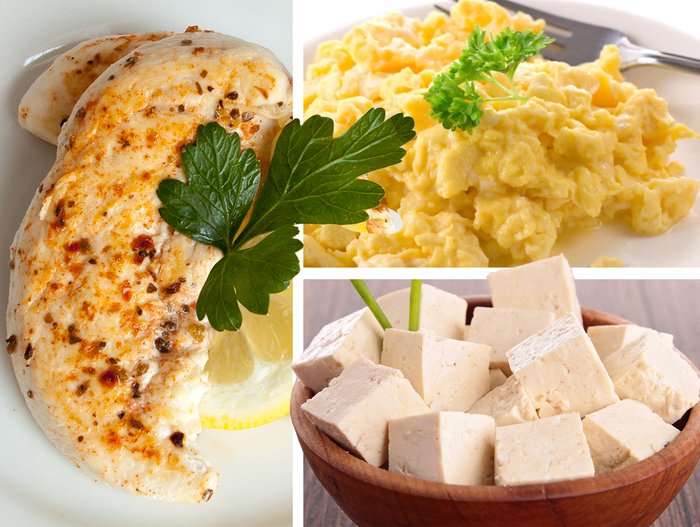
- Beef
- Skinless poultry
- Pork
- Bison
- Ground meats
- Game meats
- Tilapia
- Tuna
- Salmon
- Sardines and other small canned fish
- Ricotta cheese (whey)
- Cottage cheese (casein)
- Low-fat paneer
- Greek yogurt
- Egg whites
- Whole eggs
- Soy/tofu
- Plant-based protein or beans
- Whey protein
Carbs
The strength and endurance workouts in Man of Iron are highly glycolytic in nature, which means your body will require a specific type of energy in order to perform at its maximum capacity. The starchy carbohydrate sources below are the best choices for this purpose.
To make this diet work for you, you also need to consume plenty of fiber from sources like leafy green vegetables. The gut is where your body breaks down all of the food you eat and then absorbs it. This is how you recover, grow, and thrive: through nutrient assimilation. In order to sustain perfect gut health, consume a serving of green vegetables with each meal.
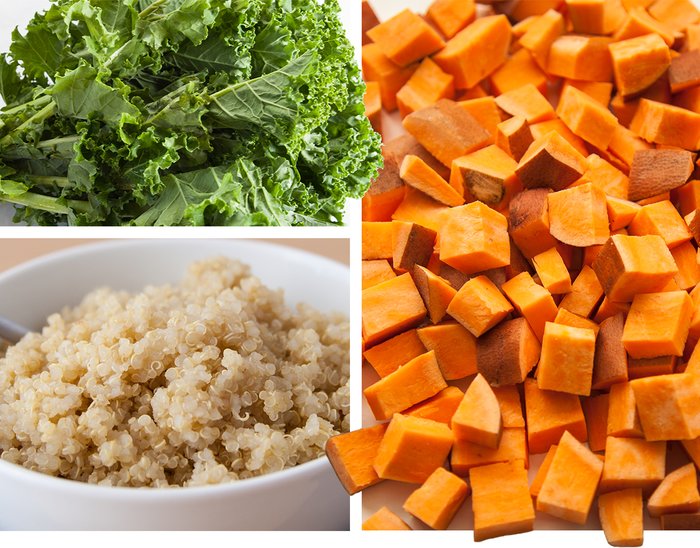
- Quinoa
- Brown rice
- Whole grains like bulgur or spelt
- Raw or cooked vegetables
- Whole, raw fruit
- High-fiber bread
- Oats
- Muesli
- Potatoes
- Sweet potatoes
- Salad greens
- Green vegetables
Fats
Fats are a highly efficient form of calories, and they're essential to hormonal health. You may find your stomach doesn't like it if you eat them around your endurance workouts, so experiment with timing to determine your tolerance.
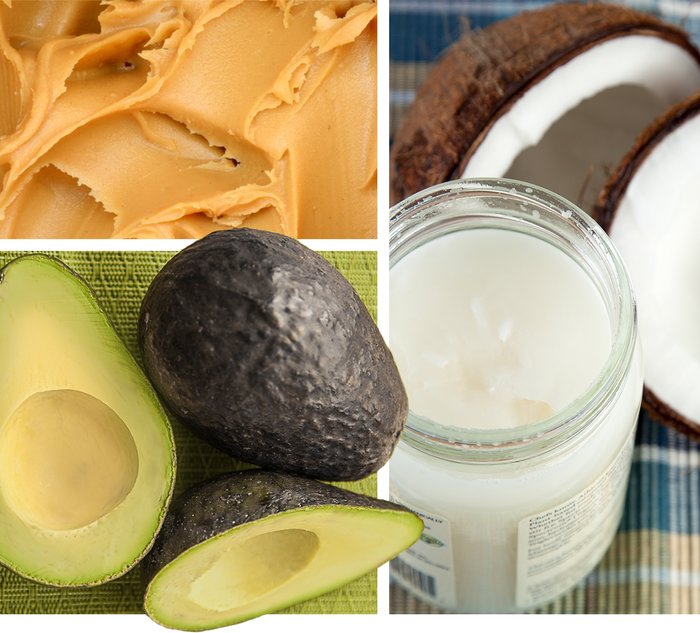
- Extra-virgin coconut oil
- Olive oil
- Canola oil
- Avocados and avocado oil
- Nuts and seeds
- Fatty fish
- Natural nut butters
Water and Other Fluids
It's easy to forget the role water plays in any training program and overall health. Keeping your body hydrated around the clock is absolutely crucial to burning fat, building muscle, aiding recovery, and guaranteeing optimized performance at every workout.
For Man of Iron, you need to consume a minimum of 1 gallon per day, sometimes more, depending on the climate you live in and how much you find you sweat during the endurance training. To further the hydrating properties of your water, Kris recommends adding Hydra-Charge 2-3 times per day to benefit from the five naturally occurring electrolytes.
"Don't forget to drink while you're swimming as well," Kris advises. "You sweat more than you think in the water!"
- Water
- Coconut water
- Black coffee
- Green tea
- Unsweetened and cream-free teas
- Water flavored with Hydra-Charge and BCAAs
Weekends: The Rolling Buffet
Kris' weekend training during Man of Iron is unique to say the least. On any given Saturday, he might be undertaking an 80-mile bike ride through hilly terrain in hot weather. Other times, he may be doing a long bike ride plus a short run, or a long run and an open-water swim, or some other combination of the three triathlon components.
Fueling for this much variety is more art than science, but Kris attacks it aggressively and as systematically as possible. "I can't believe how much I have to eat on those days," he says. "It's like a rolling buffet when I'm out there." Here's how he does it.
Weigh yourself at the start of the day and the end of your activity. The first time you do this after a long endurance workout, you may be surprised by how much weight you've lost! Some of that is definitely sweat loss, and being proactive about drinking both water and BCAAs will help. But you also need to eat enough calories to make up for what you've lost. Kris says his goal on epic weekend training days is to stay within 3 pounds of where he started the day. He weighs himself once his training is done on that day, then alters his future plan accordingly.
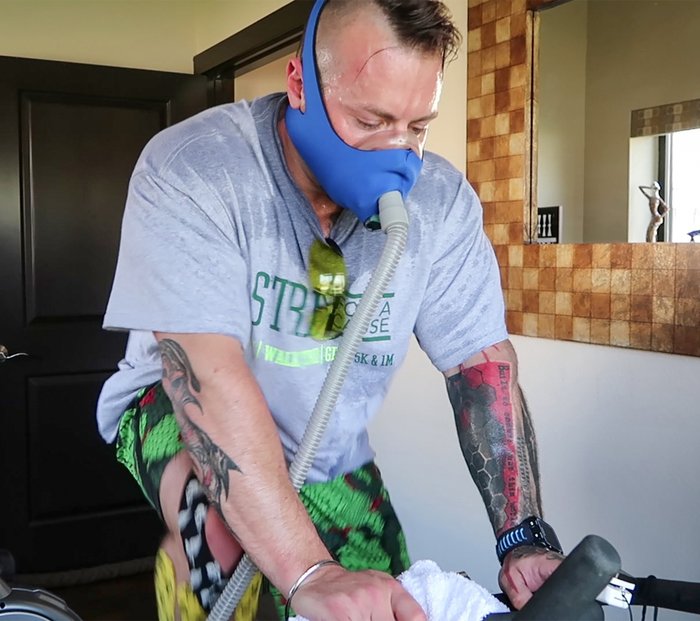
Track calorie burn as much as possible. Kris has a power-tracking stationary bike, which helps him track calories burned with remarkable accurately. You may not have access to that type of equipment, but he recommends investing in a heart rate monitor and an app to help calculate calorie burn during your long runs, rides, and swims. Make sure to eat enough to match that burn, and then some.
Start your journey with a shake. When he's heading out for an epic ride, Kris brings along a shaker bottle containing a unique blended concoction of carbs and protein that helps him stay fueled and stave off muscle loss:
- Bananas, 3
- Dates, 8
- Oats, 1/2 cup
- Honey, 2 tbsp
- Re-Kaged Protein, 2 scoops
- Water, as necessary to blend
During the ride, further fuel yourself with things like Stinger waffles, fruit, and protein as needed. For the rest of the day, eat as if it is any normal day of the week.
Yes, this will launch your daily calories through the roof. But you must embrace it fearlessly! This is a whole new world of training, and you'll need to fuel yourself like a high-performance machine to perform like one.
Supplements
Kris created a custom supplement stack to help him get the most out of his hybrid workouts and epic endurance training. As with the nutrition plan above, work to master your airtight system during the week, and then use what you've learned to tackle the unpredictable nature of weekend workouts.
The nice thing about epic rides and runs is that you need water during them anyway, so adding a scoop of crucial supplemental nutrients to a bottle you're already carrying doesn't add any weight. If you bike or run with a small satchel, pocketed jersey, or other garb that allows you to carry small items, predose your supps in small baggies and keep them packed away.
 Re-Kaged
Re-Kaged
 In-Kaged
In-Kaged
 Re-Kaged
Re-Kaged

